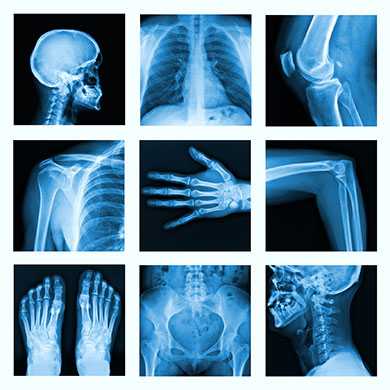Radiation in Medicine: X-Rays
An x-ray is an image created on photographic film or electronically on a digital system to diagnose illnesses and injuries. During this type of medical imaging procedure, an x-ray machine is used to take pictures of the inside of the body. The x-rays pass through various parts of the body to produce images of tissues, organs, and bones.
Every day, in hospitals and in doctor’s offices, people have medical imaging tests to diagnose diseases and injuries. Some of these tests such as x-rays involve exposure to ionizing radiation which can present risks. However, if patients understand the benefits and risks, they can make the best decisions about their health care.
What are some common medical imaging tests that use ionizing radiation?
Most people have had one or more medical imaging tests that use ionizing radiation. The type of imaging procedure that your doctor may suggest will depend on your health concern and the part of the body that is being examined. Some other common examples of imaging tests include:
If your doctor suggests x-rays or other medical imaging procedures you should consider the following:
- Medical imaging tests should be performed only when necessary.
- The U.S. Food and Drug Administration (FDA) recommends discussing the benefits and risks of x-ray procedures with your doctor.
What are the benefits and risks of x-ray?

X-ray imaging tests are painless procedures that allow doctors to diagnose diseases and injuries without being invasive. These tests also help doctors to:
- Determine whether surgery is a good treatment option
- Locate tumors for treatment
- Determine joint replacement options and treatment for fractures
- Guide in the treatment for dental, spine and chest illnesses and diseases
As in many areas of medicine, there are risks associated with the use of x-ray imaging, which uses ionizing radiation to create images of the body. Because the amount of radiation used in a normal x-ray procedure is small, there is a small risk for the patient. However, it is still important for patients to understand what to do if an x-ray procedure is suggested.
FDA recommends the following to reduce the risks of medical x-ray exposures:
- Ask your health care professional how an x-ray will help.
- Ask your health care professional if there is an equally good “non x-ray” alternative test available (for example, ultrasound).
- Don’t refuse an x-ray if your doctor explains why it is medically needed.
- Don’t insist on an x-ray if your doctor does not recommend it.
- Tell the x-ray technologist in advance if you are, or might be, pregnant.
- Ask if a protective shield can be used for areas of your body that do not need to be imaged.
- Keep track of your x-ray history.
What are the risks of medical imaging procedures for pregnant women?
Talk to your physician about the potential risks and benefits from the medical procedures. In many cases, the risk of an x-ray procedure to the mother and the unborn child is very small compared to the benefit of finding out about the medical condition of the mother or the child.
Many doctors use ultrasound to examine the abdomen, pelvic area, or heart. Ultrasound does not use ionizing radiation, so it does not expose women of childbearing age to radiation in the pelvic area. This is particularly important in pregnancy. For more information, please see the Image Wisely website.
Risks that are considered small should not be taken if they’re unnecessary. You can reduce risks from medical imaging procedures by telling your doctor if you are, or think you might be, pregnant whenever an abdominal x-ray is suggested by your doctor. Other options suggested by FDA that may be considered are as follows:
- If you are pregnant, the doctor may decide that it would be best to cancel the medical imaging procedure, to postpone it, or to modify it to reduce the amount of radiation.
- Depending on your medical needs, and realizing that the risk is very small, the doctor may feel that it is best to proceed with using a medical imaging procedure as planned.
In any case, you should feel free to discuss the decision with your doctor. For more information on medical imaging and pregnancy, please see X-rays, Pregnancy and You. Also, for more information on radiation safety in adult medical imaging, please visit the Image Wisely website.
Are there special considerations for children?

It is important that x-rays and other imaging procedures performed on children use the lowest exposure setting needed to obtain a good clinical image. The Image Gently Alliance, part of the Alliance for Radiation in Pediatric Imaging suggests the following for imaging of children:
- Use imaging when there is a medical benefit.
- Use the most appropriate imaging techniques, matched to the size of the child.
- Use alternative imaging methods (such as ultrasound or MRI) when possible.
The FDA also provides information for parents, patients and healthcare providers to address concerns about the benefits and risks of medical imaging procedures for children.
Are there medical imaging tests that do not use ionizing radiation?
There are medical imaging procedures such as Magnetic Resonance Imaging (MRI) or ultrasound that do not use ionizing radiation to diagnose illnesses or injuries.
What is an MRI?
MRI procedures, which can lasts from 30-60 minutes, use magnetic fields and radio waves to produce images of specific parts of the body. MRI scans are often performed along with other medical imaging procedures to provide a more detailed view of the area of the body that is being examined. For more information on MRI, please see FDA’s website on MRI (Magnetic Resonance Imaging).
What is an ultrasound?
Ultrasound imaging uses high-frequency sound waves to see inside the body. There is no ionizing radiation used and in most ultrasound examinations, no contrast is given.
Related Links
FDA
- Reducing Radiation from Medical X-rays
- Pediatric X-ray Imaging
- Radiology and Children: Extra Care Required
- X-Rays, Pregnancy and You
- Medical X-rays: How Much Radiation are You Getting
Image Gently
EPA
- RadTown USA Medical X-Rays
- Radiation Protection Guidance for Diagnostic and Interventional X-Ray Procedures
US National Library of Medicine
- Page last reviewed: October 17, 2016
- Page last updated: November 8, 2016
- Content source:


 ShareCompartir
ShareCompartir